The Doomino Effect for Jan 21, 2009
In this episode: Green Lantern #37 | Amazing Spider-Man #583 | Guardians of the Galaxy #9 | Mysterius the Unfathomable #1 | Superman Beyond #2

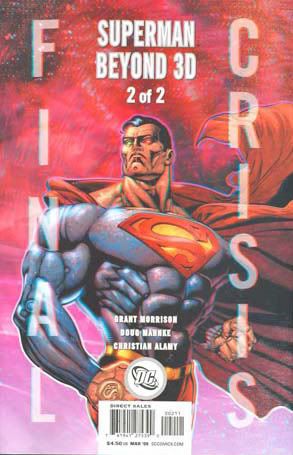 Speaking of Superman Beyond 3D #2, I skipped the first issue last summer because it struck me as dumb. Then Doom DeLuise told me that issue #1 explained how Superman could look away from Lois in Final Crisis #3 without killing her. I thought “Oh … that’s good. At least Grant Morrison felt that was something that needed acknowledging.” Nevermind that someone with so much contempt toward external continuity regarding his Big Event would then create some necessary external continuity, but that’s another topic for an already-happened day.
Speaking of Superman Beyond 3D #2, I skipped the first issue last summer because it struck me as dumb. Then Doom DeLuise told me that issue #1 explained how Superman could look away from Lois in Final Crisis #3 without killing her. I thought “Oh … that’s good. At least Grant Morrison felt that was something that needed acknowledging.” Nevermind that someone with so much contempt toward external continuity regarding his Big Event would then create some necessary external continuity, but that’s another topic for an already-happened day.
For the life of me, I had a hard time remembering what happened in the first issue, even though DD loaned it to me a week or two ago, so I got the copy out again to cheat. A bunch of Supermen and Superman peers from across the multiverse were gathered to save the cosmos from the Destroyer, the “Echo of Midnight,” bashing on this big bad ship as they careen diagonally through the multiverse, and they ended up in Limbo. They found a book that basically gave the DC multiverse its own point-for-point version of the Valentinian origin of existence. I’m not sure why Dan DiDio thought it was a good idea to let Grant Morrison rewrite the DC properties as an update of a 2,000-year-old gnostic tradition, but I also don’t get why they brought Wally back so soon before bringing Barry back. Best I can tell, the story also revealed that Superman is basically a reflection of some kind of Monitor archetype. But Mandrakk the Evil Monitor arrives at the very end, and Ultraman is quite happy about this.
So now, issue #2. By gnostic terms, it appears as if Mandrakk is some Lucifer / Demiurge composite, as Ultraman explains “There is a God. And he hates us all,” and he refers to his love of material extistence. I could be off on my gnostic mythology, but that seems to fit, especially considering how we later find out that Mandrakk was once Dax Novu, a.k.a. The Radiant One, a.k.a. the first son of Monitor, and we also find that he and the Christ / Big Robot Superman entity fit into some kind of cosmic duality, not unlike our Superman and Ultraman. But that lady monitor, whose name I keep forgetting, informs us that Mandrakk’s arrival means “the circle of monitors has fallen.” You know, for something that huge and profound, I really wish I could’ve seen that drama unfold rather than just being told it happened in a single word balloon.
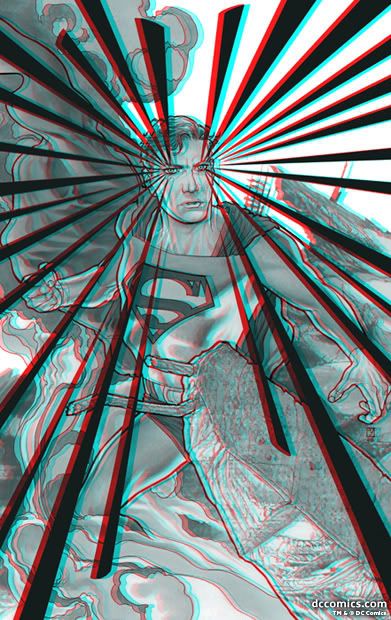 Back to the duality issue, Captain Adam explains that the Big Superman is a “thought robot” powered by dualities, but not dualities, symmetries. The significance of that clarification is over my head, but the way in which it is exercised was pretty obvious. Ultraman’s anger had to collide with Superman’s altruism in order to go boom. The interpretation of the action is irrelevant; the action mattered. Kind of ironic, given that the thought was less important than the material collision. Or maybe the material collision was just a reflection of the thought collision. I don’t know. The important thing was probably that Superman’s understanding of the collision connected the consciousness to the Pleroma, a.k.a. Monitor City. And at that point, his consciousness activates the Thought Robot Superman, the Christ archetype, in order to battle Mandrakk, the manifestation of the Demiurge.
Back to the duality issue, Captain Adam explains that the Big Superman is a “thought robot” powered by dualities, but not dualities, symmetries. The significance of that clarification is over my head, but the way in which it is exercised was pretty obvious. Ultraman’s anger had to collide with Superman’s altruism in order to go boom. The interpretation of the action is irrelevant; the action mattered. Kind of ironic, given that the thought was less important than the material collision. Or maybe the material collision was just a reflection of the thought collision. I don’t know. The important thing was probably that Superman’s understanding of the collision connected the consciousness to the Pleroma, a.k.a. Monitor City. And at that point, his consciousness activates the Thought Robot Superman, the Christ archetype, in order to battle Mandrakk, the manifestation of the Demiurge.
So then comes the big fight, since this is, despite all indications, a superhero story. As one gets stronger, so does the other. They’re balanced, since that’s how it is. And apparently the way to defeat Mandrakk is to tell him he was Dax Novu. That makes Mandrakk fall off cliffs. Then Superman returns to Limbo to smash missiles. Then Ogama, who I guess was doing Mandrakk’s dirty work in Monitor City, shows up in Limbo and turns Ultraman into a Vampire Superman.
I really really hope these aren’t the bad guys in Final Crisis #7, but thanks to Superman’s epitaph, I’m afraid they will be. Ogama seems to perfectly mirror how that other monitor was cast down to a lower plane where he could do no harm as well, and that other monitor sure hasn’t done much in Final Crisis. Lesson to monitors: stop throwing people down to lower planes.
But Superman returns to the hospital in the space of one heartbeat. Want to know how he manages to bring Bleed back to save Lois, even though “Nothing can hold or contain bleed” ? He just does it, because Superman can hold Bleed and they were wrong. Way to think your way out of that one, sir.
Over at the Comic Book Revolution, Rokk opines that “This story is engrossing and completely envelops the reader’s imagination and attention,” and that “The result is the reader feeling as if absolutely anything could happen at any moment.” I completely disagree with the first statement, but it’s because I completely agree with the second. The sense that absolutely anything could happen at any moment pulled me out of the story. It was obvious the rules didn’t apply, but sometimes you need a mutual understanding of “the rules” between reader and author in order for the author’s intended drama to be conveyed. I felt no sense of story, just that Morrison wanted a certain sequence of things to happen because he wanted them to happen.
 Rokk continues, “Ancient myths were not tales centered on realism. They were outlandish stories of unimaginable gods and monsters. Men with flying horses and golden fleeces.” This is true, but those stories existed to convey a sense of cause and effect, morality and consequence. This story felt hampered by a desire to cram an existing world of stories into a separate mythological structure. The irony of this is that Rokk contrasts this with writers who try to force superheroes into a similarly incompatible world of “real life.” I’m with him that I don’t like creators forcing superhero comics into real-life contexts, but I’m not sure I give any kind of creative or intellectual upper hand to the idea of cramming them into second-century religious movements or Christ / Satan archetypes. (Sorry if it looks like I’m going after Rokk; he just always provides a very thoughtful analysis of the books he reviews, so he’s a great source if you want to make a counterpoint.)
Rokk continues, “Ancient myths were not tales centered on realism. They were outlandish stories of unimaginable gods and monsters. Men with flying horses and golden fleeces.” This is true, but those stories existed to convey a sense of cause and effect, morality and consequence. This story felt hampered by a desire to cram an existing world of stories into a separate mythological structure. The irony of this is that Rokk contrasts this with writers who try to force superheroes into a similarly incompatible world of “real life.” I’m with him that I don’t like creators forcing superhero comics into real-life contexts, but I’m not sure I give any kind of creative or intellectual upper hand to the idea of cramming them into second-century religious movements or Christ / Satan archetypes. (Sorry if it looks like I’m going after Rokk; he just always provides a very thoughtful analysis of the books he reviews, so he’s a great source if you want to make a counterpoint.)
So overall, I felt completely underwhelmed by Superman Beyond. It was interesting to get a few looks into other Earths throughout the multiverse, but that alone wasn’t near enough to carry it for me. I also hated the 3D gimmick. The 3D imagery wasn’t very effective, the glasses were awkward, but it gave me a headache to read the 3D parts without the glasses. The gimmick was sparsely used in part 2 anyway. That said, I really liked Doug Mahnke’s art, and Final Crisis #7 shouldn’t suffer for more than the obvious reasons by turning to him as a fill-in.

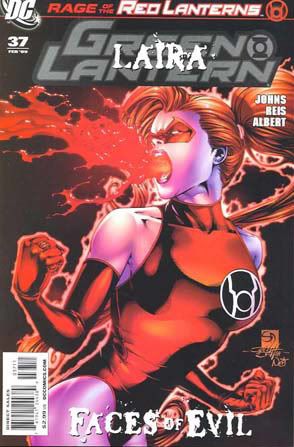 Speaking of carrying the bleed inside you, that leads me to Green Lantern #37, in which those blood-spewing Red Lanterns have abducted Sinestro. Hal Jordan tracks him down to Ysmault, where his ring keeps reminding him that lethal force is authorized in order to carry out Sinestro’s execution.
Speaking of carrying the bleed inside you, that leads me to Green Lantern #37, in which those blood-spewing Red Lanterns have abducted Sinestro. Hal Jordan tracks him down to Ysmault, where his ring keeps reminding him that lethal force is authorized in order to carry out Sinestro’s execution.
The Red Lanterns ambush Hal, and Atrocitus informs Hal that he will become renegade once more. The Guardians will take his greatest love from him and he will revolt. Sinestro warns Hal that Atrocitus’ prophecies are just reverse psychology to knock Hal off his game. And then the Yellow Lanterns attack to free Sinestro, and then the Blue Lanterns arrive to try to convince Hal to join them. And then just as Hal is starting to get through to Laira, Sinestro kills her, or as he sees it, saves Hal’s life. So Hal gets really mad, see? And then Atrocitus says he knows the weakness of the Blue Lanterns, even though they’re like super totally new and everything. So that was fun while it lasted.
But the best part? Hal Jordan becomes a Red Lantern. Booooooo.
Not only did the idea of Hal Jordan succumbing to the powers of a non-green ring leave me feeling flat (we’re on issue #37 because it was only a little more than three years ago that Hal came back from the effects of his last stint under the influence of a non-green power; and about a year ago, Kyle became Parallax too), but the idea of Hal falling victim to his rage seemed to ignore what I thought was the most relevant moment of the recently concluded Secret Origin series — when Hal learned to let go of his anger. So were we told of this great lesson just to watch him forget it a few issues later? And what was the point of Atrocitus sharing the prophecy if it was going to come true at the end of that issue? Way to build that up for dramatic impact.
Maybe Hal’s going to just cycle through every color. He’s done green and yellow. The blues say they want him too. The pinks should be fun.

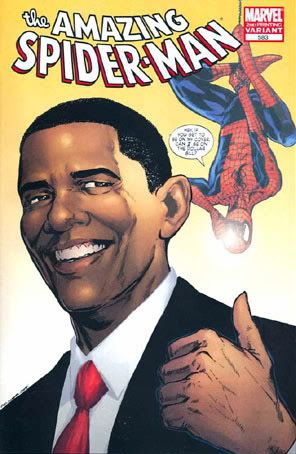 Speaking of powerful beings of all colors, that leads me to Amazing Spider-Man #583, in which President Barack Obama makes a guest appearance.
Speaking of powerful beings of all colors, that leads me to Amazing Spider-Man #583, in which President Barack Obama makes a guest appearance.
I’m glad I got the second printing. It’s obviously worth less than the first printing, but I like the cover better for my purposes.
I actually have no desire whatsoever to read this book. I don’t care about Spider-Man, and the premise seems dumb. I just bought this to go in my box of newspaper front pages, issues of Time, the issue of The Economist with their Obama endorsement, and the December ’07 issue of The Atlantic with that great cover story by Andrew Sullivan.
It’s just stuff to show the grandkids.
(Unlike the rest of my comics, which I’ll probably have thrown away by then.)

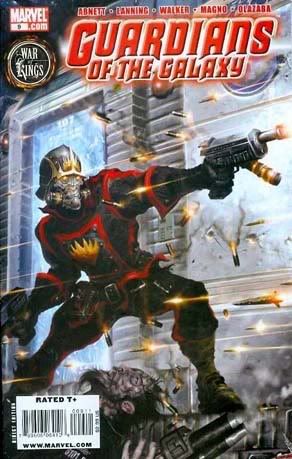 Speaking of putting things in boxes, that leads me to Guardians of the Galaxy #9, which follows Star Lord’s adventures after being tossed in the Negative Zone. He meets up with the inmates of 42, the Negative Zone prison established during the Civil War, in order to talk them into surrendering to Blastaar. Blastaar wants to use 42’s access to the real world as a way of launching an attack on Earth. Some extremely lame Marvel villains make cameos as Star Lord and unlicensed vigilante Jack Flag talk terms.
Speaking of putting things in boxes, that leads me to Guardians of the Galaxy #9, which follows Star Lord’s adventures after being tossed in the Negative Zone. He meets up with the inmates of 42, the Negative Zone prison established during the Civil War, in order to talk them into surrendering to Blastaar. Blastaar wants to use 42’s access to the real world as a way of launching an attack on Earth. Some extremely lame Marvel villains make cameos as Star Lord and unlicensed vigilante Jack Flag talk terms.
Meanwhile, on Titan, Drax and Quasar talk to some guy I don’t know anything about who betrays them. I didn’t see that coming, but I didn’t see anything coming because I have no idea who that guy is.
Major Victory is having a chat with Starhawk, trying to remember stuff, when Mantis gets Star Lord’s distress call from the Negative Zone, which results in the whole gang being teleported to the middle of a battle.
I’m running out of ways to say I love this series. Even an issue like this, which was somewhat underwhelming, does nothing to harm my commitment to it. I do miss Paul Pelletier’s art, though.
Speaking of having nothing else to say about something, Mysterius the Unfathomable #1 was our Book of Doom this week. I liked it.
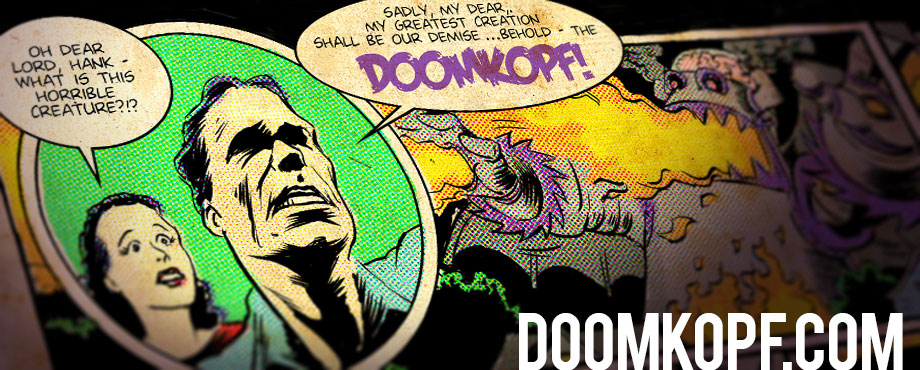
This might be the most intelligently written blog about superheroes I’ve ever read.